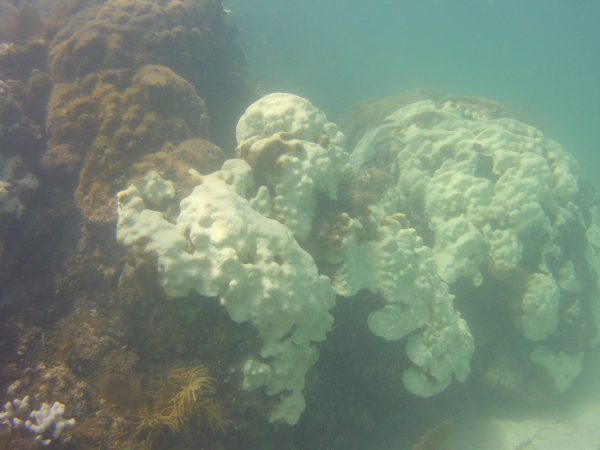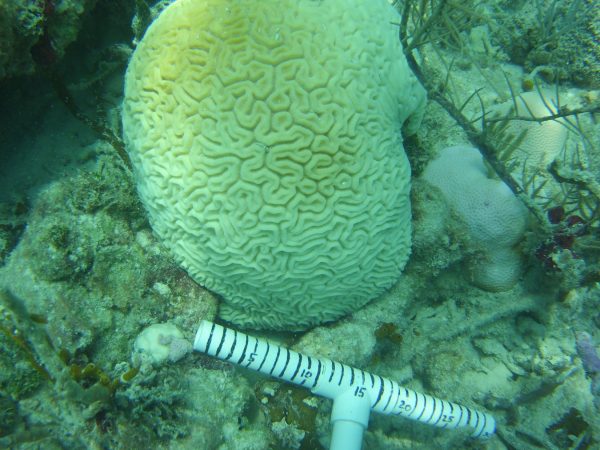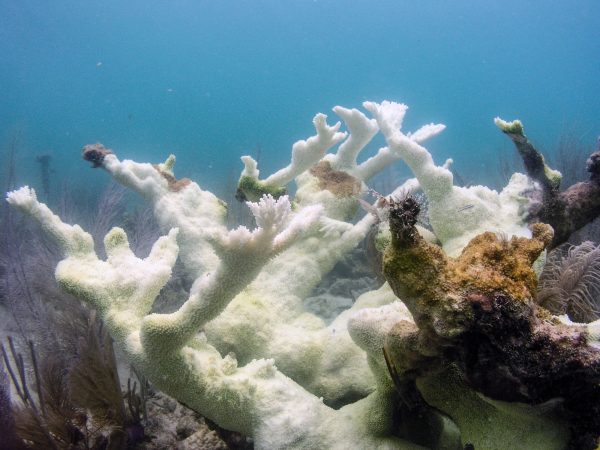Featured image: Lush thicket of staghorn coral in the Dry Tortugas National Park. Credit: Ilsa Kuffner, USGS.
The takeaway message:
In July 2023, a water monitoring station in Manatee Bay, Florida, recorded a temperature of 101.1 °F. Scientists say these extremely warm temperatures pose harm to the marine ecosystem, can exacerbate extreme weather events, and hinder Florida’s economy. As the climate continues to warm, researchers are bracing for the impacts.
What’s going on?
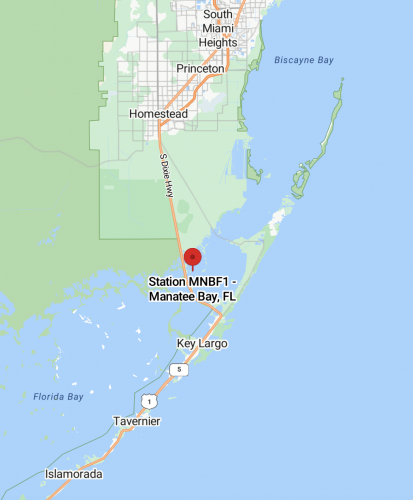
On July 24, 2023, the National Oceanic and Atmospheric Administration (NOAA) recorded a water temperature reading of 101.1 °F (38.4 °C) at Station MNBF1 in Manatee Bay, Florida. Manatee Bay is located between the Southern tip of Miami Dade County and Key Largo. The night before, that same monitoring buoy read 100.2 °F (37.9 °C). For comparison, hot tub water is usually kept between 100 °F and 102 °F.
While this temperature reading has been described as record-breaking, its confirmation remains uncertain due to inconsistent documentation of historic ocean temperatures. If validated, this water temperature reading would surpass the prior record of 99.7 °F (37.6 °C) set three summers ago in Kuwait Bay, located in the northwestern Persian Gulf.
The bigger picture
Following three years of a cooler climate pattern called La Niña, Earth is now experiencing its counterpart, El Niño. This warmer climate variation in the Pacific Ocean and a similar pattern in the Atlantic have set the stage for extreme ocean temperatures globally.
In fact, in August 2023, 39% of the global ocean was experiencing a marine heatwave. Marine heat waves are events characterized by higher-than-average monthly regional sea surface temperatures when compared to the 1991-2020 averages. They can persist for weeks, months, or even years, and result in devastating consequences for marine ecosystems, including mass mortalities of marine animals and plants.
To visualize the extent of marine heat waves, the NOAA Physical Sciences Laboratory has developed predictive models. These forecasts indicate a 70-100% likelihood that extreme ocean temperatures will endure in the southern Gulf of Mexico and Caribbean Sea at least until October 2023. An elevated marine heatwave risk will remain in effect for 35% of the global ocean until the end of the year.
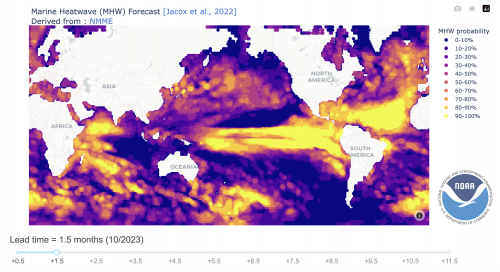
Why it matters.
Higher ocean temperatures can lead to coral reef bleaching events and exacerbate extreme weather events, both of which have an impact on Florida’s economy.
Coral Reefs
Coral reefs are formed by colonies of living coral polyps that secrete calcium carbonate to construct hard exoskeletons that accumulate over thousands of years. The waters surrounding Florida are home to a shallow, living coral reef formation stretching from Dry Tortugas National Park to the St. Lucie Inlet. Florida’s Coral Reef is the only living coral barrier reef in the continental United States and the third largest coral barrier reef system in the world.
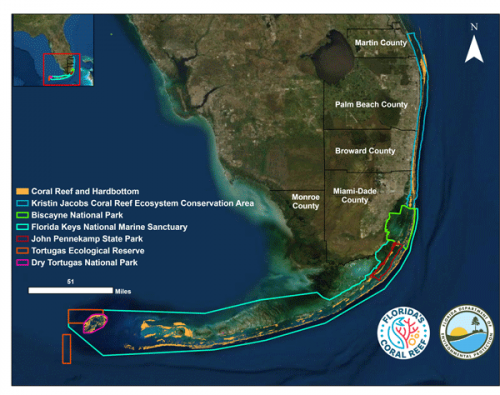
The reef plays a vital role in the marine ecosystem, providing shelter, sustenance, and breeding grounds for diverse marine life. Coral reefs also provide substantial physical benefits to shorelines, shielding them from erosion, flooding, and extreme weather events. A 2019 report by the United States Geological Survey (USGS) estimated the annual flood risk-reduction value of Florida’s coral reef to be $1.1 billion.
Beyond their ecological importance, coral reefs offer invaluable education, recreation, and research opportunities. Everything from Florida’s fishing industry to the tourism sector to general coastline stability relies on the health of these coral reef organisms.
Ana Zangroniz, Florida Sea Grant agent with UF/IFAS Extension in Miami-Dade County, emphasized that the location in Manatee Bay where the extremely high temperature was recorded does have corals, but it is not officially part of Florida’s Coral Reef tract. The actual reef tract is located offshore in the ocean. While it has not experienced the 101.1-degree temperature, it has been suffering from heat stress.
The unprecedentedly high ocean temperatures place these corals at severe risk of coral bleaching. High-temperature stress can cause coral hosts to expel the colorful microscopic photosynthetic algal cells, called zooxanthellae, from their tissues.
 Fully bleached Orbicella faveolata (Mountainous star coral) on Alina’s Reef in Biscayne National Park. These colonies are at least 6’ in diameter, indicating that they are quite old.
Fully bleached Orbicella faveolata (Mountainous star coral) on Alina’s Reef in Biscayne National Park. These colonies are at least 6’ in diameter, indicating that they are quite old. A paling, almost fully bleached Diploria labrynthiformis (Grooved brain coral) in Biscayne National Park.
A paling, almost fully bleached Diploria labrynthiformis (Grooved brain coral) in Biscayne National Park. The Elkhorn coral, Acropora palmata, in Dry Tortugas National Park that has bleached because of the summer 2023 ocean-heat wave.
The Elkhorn coral, Acropora palmata, in Dry Tortugas National Park that has bleached because of the summer 2023 ocean-heat wave.
The loss of zooxanthellae equates to a loss of food for corals. The sugars that zooxanthellae supply to the corals are necessary for coral growth, and the nitrogen that the corals collect from the prey they catch is necessary for zooxanthellae growth. This mutualistic relationship facilitates efficient nutrient recycling in nutrient-poor tropical waters.
Once corals lose their zooxanthellae, they will slowly starve if temperatures do not return to normal. If they do not die, they can become more susceptible to diseases and predation and may have lower reproductive rates. When a food deficit lasts longer than the corals can tolerate, the corals will starve and die.
However, zooxanthellae can repopulate if the extreme temperatures that cause bleaching subside. Repopulation of zooxanthellae allows coral tissue to recover and resume the reef-building process that the marine ecosystem relies on. If the coral does die, the skeleton that remains can bioerode, or degrade.
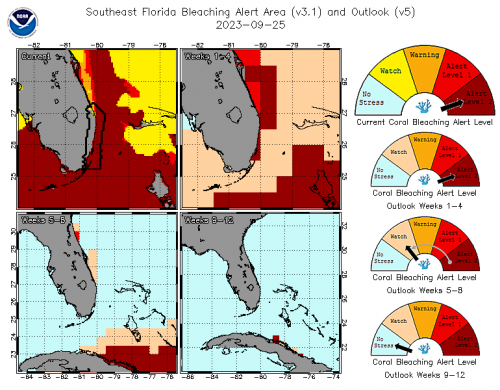
“Without a structurally sound reef, southeast Florida can suffer ramifications of this [heat stress] immediately, as the first natural barrier to major wave movement from storms becomes less effective,” Zangroniz said.
She also warns that without a healthy reef system, there are potential cascading economic impacts.
“People would not travel to enjoy recreational activities, such as snorkeling, fishing, and diving. Cultural and aesthetic experiences would be lost,” Zangroniz said. “Commercial and recreational fishing would go down, impacting both job opportunities as well as food sources.”
Coral bleaching has been documented in Florida for over a century, but alarming indications suggest an increase in both frequency and severity since the 1980s.
Ilsa Kuffner, a research marine biologist at the St. Petersburg Coastal and Marine Science Center, investigates the causes and effects of coral reef degradation.
“It’s not just a bleaching event anymore. Now, it’s becoming a mortality event,” Kuffner said.
“The corals are dying. And it is because of these extreme temperatures that they’re experiencing.”
Extreme Weather
Beyond the reefs, ocean temperatures influence weather events. Research conducted in the Gulf of Mexico shows that warm atmospheric and ocean temperatures can compound and create stronger hurricanes, storms, and rainfall. As ocean waters warm, the air above the surface gains energy, resulting in the potential for more potent and destructive storms. When coupled with weak upper-level winds and moisture-laden atmospheres, warm ocean waters can trigger the rapid intensification of storms, raising the stakes for communities in their path.
Elevated temperatures can exacerbate existing environmental challenges like coral bleaching, the occurrence of hypoxia (low oxygen levels in the water), and other issues that have been forecasted to intensify with the progression of global warming.
What can I do?
Wondering what you can do to lessen the impact of rising ocean temperatures?
Zangroniz recommends thinking about our daily lives and behaviors, saying, “changes don’t have to be big to be impactful.” Daily changes can help reduce the carbon dioxide emissions that fuel global warming. She offers the following tips to reduce emissions:
- In cold weather, lower your thermostat by two degrees when you leave the house, in warm weather, raise your thermostat by two degrees instead.
- Consider carpooling, walking, biking, or taking public transit.
- If ordering online, choose the U.S. Postal Service as the delivery service. The USPS has daily routes that are already being driven, so delivery of your package does not require another vehicle to be on the road.
- Hang dry clothing so you don’t have to run your dryer.
- Learn more about climate-forward policy proposals and conservation projects you can support.
Finding solutions to help mitigate climate change also involves supporting science and becoming an informed citizen on the community level. Aside from your daily habits, Kuffner offers the following approaches:
- Learn about and get involved in environmental organizations and climate initiatives in your area. By doing so, you can use your unique skill sets for a bigger cause.
- Be a critical reader. When reading about environmental issues, be discerning about your information sources. Seek credible, science-based information to better understand the complexities of climate change and its impacts on our world.
- Embrace science. Pay attention to what science is telling us. Climate change is an urgent global challenge, and it is essential to stay informed about its consequences.
Learn more:
- About coral bleaching
- About ocean temperatures and hurricanes
- About reef restoration efforts
- About the current state of an urban reef environment CoralCoral City Camera
